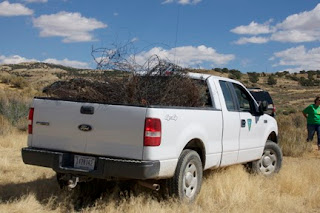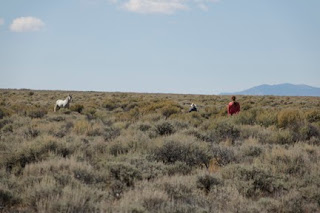 |
| SWAT Rendevous, September 2016 |
We anxiously anticipated what we would find when we visited
the Sand Wash Basin wild horse herd.
The
Sand Wash Basin area appears to be the largest Horse Management Area (HMA) in
Colorado, including 157,000 acres and nearly 600 wild horses.
TJ from the Spring Creek Basin herd had
invited us to the SWAT Rendevous…. a work day with the Sand Wash Basin
Advocacy Team.
We were interested in
finding out more about their work with wild horses, particularly after a dear
friend texted me that a Colorado newspaper had just reported the BLM had voted
to euthanize 45,000 wild horses.
We spent Friday afternoon traveling the wildlife loop.
The loop was gravel, rutted in many places,
and required a high-clearance vehicle.
Within minutes, we discovered our first wild horse band.
 |
| Sand Wash Basin wild horse band |
 |
| Sand Wash Basin foal |
 |
| Sand Wash Basin stallion |
Invited by photographer and SWAT member Patti
Moseby to join her at their camp. Once
we settled in, Patti invited us over for a fajita dinner… what hospitality! It was a wonderful time and great food. We spent the evening overlooking the Little
Snake River and watching a full moon rise over the mountains.
 |
| Camp at Sand Wash Basin |
 |
| Little Snake River Overlook |
 |
| Moon rise over Little Snake River |
The next morning, we headed to the Rendevous.
Nearly 50 folks joined us, hailing from
Colorado to Canada to Kansas to Texas (us).
Several other advocacy groups also joined the group, including TJ
representing the Spring Creek Basin herd, Ginger representing Wyoming’s Pryor
Mountain herd, and Michelle from Great Escape Mustang Sanctuary.
Representatives from the Bureau of Land
Management (BLM) also attended the event.
We began the day with a local park ranger speaking about the
archaeology that could be found in the Sand Wash Basin. Next, the group added a brochure box to an
informational kiosk. We then caravanned
to and removed the remains of an old corral, cutting and gathering barbed and
woven wire. We learned that removing
wire has become a tradition with SWAT after a beloved stallion named Greasewood
became entangled in wire, resulting in injuries that required his being put
down. We gathered and compressed two
pickup loads of wire from the old corral.
 |
| BLM truck loaded with recovered barbed and woven wire |
Our next task was unexpected.
We came upon a mare that had managed to cross
outside the HMA fence during winter.
The
group decided to try to herd her back into the HMA.
Our first attempt failed miserably.
We were able to herd her in the right
direction, but she bolted at the sight of too many people near the gate.
 |
| Sand Wash Basin mare bolts from capture |
Another attempt… another failure.
The mare ran along the fence line, hundreds of
yards from the gate.
One of the
volunteers found a weak spot in the fence and dropped it.
Several of us fanned out, attempting to form
a line to keep her along the fence, hoping to drive her into the opening.
She again broke the line.
We made one last attempt.
I watched as David and Steve dipped over a
rise, trying to herd the mare back again to the fence opening.
Several of us fanned out, attempting to look
like a formidable line to prevent her bolting again.
The majority of the group, however, must have
felt that the task was impossible.
They
began leaving.
Now only five of us
remained.
The mare came over the rise and bolted away from the
fence. It was obvious that she had no
intentions of being part of our rescue plan.
We bid her farewell, fixed the fence, and walked back to our
vehicles. Already plans were being made
to find a better way to reintroduce her into the herd.
 |
| Sand Wash Basin mare outside HMA |
SWAT ended the event and evening with a wonderful hamburger
cookout. One member even brought skewers of rattlesnake, mushrooms, and green
peppers to place on the grill.
(Tastes like chicken!)
The local BLM branch manager spoke after we ate. He reassured everyone that in spite of
newspaper reports, the BLM had voted against euthanizing the 45,000 wild horses
held in corrals. I leaned over and asked
the lady sitting next to me if I had heard the numbers correctly. Yes.
The BLM currently holds 45,000 formerly wild-roaming horses in
corrals. This number was more than a
shock to me.
We also learned that the Sand Wash Basin herd, which numbers
approximately 560, has a 360-horse limit for current management levels. Rather than a “gathering,” which we learned
was driving horses by helicopter… a traumatic and dangerous reduction method…
the BLM branch manager said that they planned their first bait trap in October
to capture approximately 200 SWB horses.
The bait trap method uses pens that surround watering holes. Once penned, the BLM planned to dart mares
with fertility control and remove about 50 young horses and place them with the
Great Escape Mustang Sanctuary for gentling and, hopefully, adoption.
The evening ended on a positive note. The BLM folks thanked SWAT for their continuing efforts to work with them, including the volunteers who dart mares with fertility drugs, those who help maintain the Sand Wash Basin HMA, and for their efforts in finding homes for displaced horses. It appeared to us that the Sand Wash Basin
Advocacy Team and the BLM were working closely together to solve a complex and
challenging issue to preserve these wild horses.
Wild horses… a symbol of the American West.
We had no idea about the controversy, about
the numbers of wild horses in holding corrals, about the challenges facing those
trying to save them and the BLM trying to care for them.
Our wild horse tour is definitely not turning
out as expected.
It was turning out to
be so much more.
The next morning we took another tour around the Sand Wash
Basin. This will definitely be an area
to return to. We made new friends,
learned so much, and best of all, have seen wild horses. Wyoming is next!





